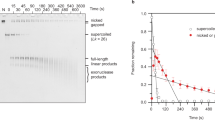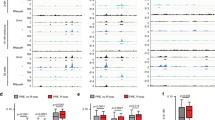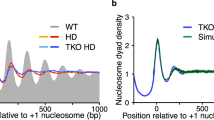Abstract
The potential for a DNA molecule to assume different tertiary structures has been suggested as a possible determinant of transcriptional regulation in eukaryotes1,2. Such forms include cruciforms3,4 transitions from B to Z DNA in the same molecule2,5 and short unpaired stretches of DNA in an alternating copolymer6. All such structures contain regions which are preferentially sensitive to S1 nuclease4–6. We report here an additional class of S1 nuclease sensitive sites associated with short direct repeats of DNA found in the 5′ flanking regions of certain Drosophila melanogaster heat shock genes.
This is a preview of subscription content, access via your institution
Access options
Subscribe to this journal
Receive 51 print issues and online access
$199.00 per year
only $3.90 per issue
Buy this article
- Purchase on Springer Link
- Instant access to full article PDF
Prices may be subject to local taxes which are calculated during checkout
Similar content being viewed by others
References
Larsen, A. & Weintraub, H. Cell 29, 609–622 (1982).
Nordheim, A., Lafer, E. M., Peck, L. J., Wang, J. C. & Stollar, B. D. Cell 31, 309–318 (1982).
Lilley, D. M. J. Proc. natn. Acad. Sci. U.S.A. 77, 6468–6472 (1980).
Panayotatos, N. & Wells, R. D. Nature 289, 466–470 (1981).
Klysik, J., Stirdivant, S. M., Larson, J. E., Hart, P. A. & Wells, R. D. Nature 290, 672–677 (1981).
Hentschel, C. C. Nature 295, 714–716 (1982).
Pelham, H. R. B. Cell 30, 517–528 (1982).
Pelham, H. R. B. & Bienz, M. EMBO J. 1, 1473–1477 (1982).
Mirault, M.-E., Southgate, R. & Delwart, E. EMBO J. 1, 1279–1286 (1982).
Ish-Horowicz, D., Pinchin, S. M., Schedl, P., Artavanis-Tsakonas, S. & Mirault, M.-E. Cell 18, 1351–1358 (1979).
Southern, E. M. J. molec. Biol. 98, 503–517 (1975).
Karch, F., Török, I. & Tissieres, A. J. molec. Biol. 148, 219–230 (1981).
Ingolia, T. D. & Craig, E. A. Nucleic Acids Res. 9, 1627–1641.
Golding, C. R. & Russell, W. C. Nucleic Acids Res. 11, 21–36 (1983).
Bienz, M. & Pelham, H. R. B. EMBO J. 1, 1583–1588 (1982).
Pelham, H. R. B. & Lewis, M. J. in Gene Expression (eds Hamer, D. & Rosenberg, M) (Liss, New York, in the press).
Weintraub, H. Cell 32, 1191–1203 (1983).
Author information
Authors and Affiliations
Rights and permissions
About this article
Cite this article
Mace, H., Pelham, H. & Travers, A. Association of an S1 nuclease-sensitive structure with short direct repeats 5′ of Drosophila heat shock genes. Nature 304, 555–557 (1983). https://doi.org/10.1038/304555a0
Received:
Accepted:
Issue Date:
DOI: https://doi.org/10.1038/304555a0
This article is cited by
-
The regulatory role of DNA supercoiling in nucleoprotein complex assembly and genetic activity
Biophysical Reviews (2016)
-
Visualisation of inter loop tertiary base pairing and stacking interactions in an unusual slipped loop DNA structure
Proceedings / Indian Academy of Sciences (1994)
-
Rapid, localized amplification of a unique satellite DNA family in the rodent Microtus chrotorrhinus
Chromosoma (1993)
-
Immunofluorescent localization of triplex DNA in polytene chromosomes of Chironomus and Drosophila
Chromosoma (1991)
-
H-form DNA and the hairpin-triplex model
Nature (1988)
Comments
By submitting a comment you agree to abide by our Terms and Community Guidelines. If you find something abusive or that does not comply with our terms or guidelines please flag it as inappropriate.



